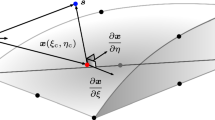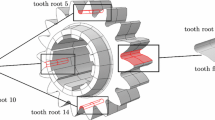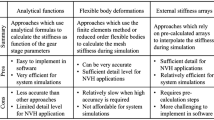Abstract
In this work we present a novel method for the solution of gear contact problems in flexible multi-body. These problems are characterized by significant variation in the location and size of the contact area, typically requiring a high number of degrees of freedom to correctly capture deformation and stress fields. Therefore fully dynamic simulation is computationally prohibitive. To overcome these limitations, we exploit a combined analytic-numerical contact model within a parametric model order reduction (PMOR) scheme. The reduction space consists of a truncated set of eigenvectors augmented with a parameter dependent set of residual static shape vectors. Each static shape is computed by interpolating among a set of displacement modes of the interacting bodies, obtained from a series of precomputed static contact analyses. During the contact analyses, an analytic model based on the Hertz theory describes the teeth local deformation. We implement the proposed method in an in-house code and we apply it to spur and helical gears dynamic contact analyses. We compare the results with classical PMOR schemes highlighting how the combined use of the semi-analytic contact model allows to decrease further the model complexity as well as the computational burden, for both static and dynamic cases. Finally, we validate the methodology by means of a comparison with experimental data found in literature, showing that the numerical method is able to capture quantitatively the static transmission error measurements in case of both helical and spur geared transmission for different torque levels.





















Similar content being viewed by others
Change history
05 August 2021
A Correction to this paper has been published: https://doi.org/10.1007/s11012-021-01401-8
Notes
In the remainder of this paper we will refer to \(\alpha\) and P of Eq. (20) respectively as Hertz-penetration gap and Hertz-contact force.
In the remaining of this paper the q-dependence of the matrices and vectors in Eq. (25) are implied for notational convenience.
Differently from the spur gear example, in case of aligned helical gears the complexity of the contact formulations does not vary along the angular pitch just as the number of gear axial sections in contact.
References
Andersson A, Vedmar L (2003) A dynamic model to determine vibrations in involute helical gears. J Sound Vib 260(2):195–212
Ascher UM, Petzold LR (1998) Computer methods for ordinary differential equations and differential-algebraic equations, vol 61. SIAM, Philadelphia
Blockmans B, Tamarozzi T, Naets F, Desmet W (2015) A nonlinear parametric model reduction method for efcient gearcontact simulations. Int J Numer Methods Eng 102(5):1162–1191
Cai Y (1995) Simulation on the rotational vibration of helical gears in consideration of the tooth separation phenomenon (a new stiffness function of helical involute tooth pair). J Mech Des 117(3):460–469
Chang L, Liu G, Wu L (2015) A robust model for determining the mesh stiffness of cylindrical gears. Mech Mach Theory 87:93–114
Craig J (1987) A review of time-domain and frequency-domain component mode synthesis method. Int J Anal Exp Modal Anal 2(2):59–72
Ding Ca, Zhang L, Zhou Fz, Zhu J, Zhao Sz (2001) Theoretical formula for calculation of line-contact elastic contact deformation. Tribol Beijing 21(2):135–138
Fiszer J, Tamarozzi T, Desmet W (2016) A semi-analytic strategy for the system-level modelling of flexibly supported ball bearings. Meccanica 51(6):1503–1532
Guilbault R, Lalonde S, Thomas M (2012) Nonlinear damping calculation in cylindrical gear dynamic modeling. J Sound Vib 331(9):2110–2128
Harris TA, Kotzalas MN (2006) Essential concepts of bearing technology, 5th edn. CRC Press, New York
Heirman GHK, Tamarozzi T, Desmet W (2011) Static modes switching for more efficient flexible multibody simulation. Int J Numer Methods Eng 87(11):1025–1045
Johnson KL (1987) Contact mechanics. Cambridge University Press, Cambridge
KU Leuven (2016) MUTANT: Multibody transient analysis of transmission. http://www.mech.kuleuven.be/en/pma/research/mod/research-areas/mutant
Kuang J, Yang Y (1992) An estimate of mesh stiffness and load sharing ratio of a spur gear pair. In: The 1992 ASME design technical conferences–6th international power transmission and gearing conference, Scottsdale, September 1992. Advancing Power Transmission into the 21st Century, vol 1. ASME, New York, pp 1–9
Kurokawa S, Ariura Y, Ogata A (1999) High precision measurement and analysis of transmission errors of gears under load. In: World congress on gearing and power transmission No 4, Paris, FRANCE, pp 1777–1788
Özgüven HN, Houser DR (1988) Mathematical models used in gear dynamicsa review. J Sound Vib 121(3):383–411
Palermo A, Anthonis J, Mundo D, Desmet W (2014) A novel gear test rig with adjustable shaft compliance and misalignments part I: design. Springer, Berlin
Puttock M, Thwaite E (1969) Elastic compression of spheres and cylinders at point and line contact. Commonwealth Scientific and Industrial Research Organisation, Australia. National Standards Laboratory. Technical paper
Russo R, Brancati R, Rocca E (2009) Experimental investigations about the influence of oil lubricant between teeth on the gear rattle phenomenon. J Sound Vib 321(3):647–661
Shabana A (1989) Dynamics of multibody systems. Wiley, New York
Tamarozzi T, Blockmans B, Desmet W (2015) Dynamic stress analysis of the high-speed stage of a wind turbine gearbox using a coupled flexible multibody approach. In: CWD Conference for wind power drives, Aachen, Belgium
Tamarozzi T, Blockmans B, Desmet W (2015) On the applicability of static modes switching in gear contact applications. In: ASME 2015 international design engineering technical conferences and computers and information in engineering conference, vol 10
Tamarozzi T, Heirman G, Desmet W (2014) An on-line time dependent parametric model order reduction scheme with focus on dynamic stress recovery. Comput Methods Appl Mech Eng 268:336–358
Tamarozzi T, Ziegler P, Eberhard P, Desmet W (2013) On the applicability of static modes switching in gear contact applications. Multibody Syst Dyn 30:209–219
Toso A, Van Wermeskerken F, Cappellini N, Heirman G (2015) On the effect of lightweight gear blank topology on transmission dynamics. In: ASME 2015 international design engineering technical conferences and computers and information in engineering conference
Vijayakar SM (1993) Contact analysis of gears using a combined finite element and surface integral method. Gear Technol 10:26
Weber C, Banaschek K (1953) Schriftenreihe antriebstechnik, chap 11. Friedr. Vieweg & Sohn, Braunschweig
Wriggers P (2006) Computational contact mechanics. Springer, Berlin
Acknowledgements
The authors gratefully acknowledge the support of the European Commission for their support of the Marie Curie program through the EMVEM project (GA 315967) and the IAPP DEMETRA project (GA 324336). The Research Fund KU Leuven is gratefully acknowledged for its support. The research of T. Tamarozzi is funded by a grant from the IWTVLAIO Flanders VIRTUAL MATES. The IWT agency is gratefully acknowledged also for its support within the OPTIWIND project. This research was partially supported by Flanders Make, the strategic research centre for the manufacturing industry.
Author information
Authors and Affiliations
Corresponding author
Ethics declarations
Conflict of interest
The authors declare that they have no conflict of interest.
Rights and permissions
About this article
Cite this article
Cappellini, N., Tamarozzi, T., Blockmans, B. et al. Semi-analytic contact technique in a non-linear parametric model order reduction method for gear simulations. Meccanica 53, 49–75 (2018). https://doi.org/10.1007/s11012-017-0710-5
Received:
Accepted:
Published:
Issue Date:
DOI: https://doi.org/10.1007/s11012-017-0710-5




